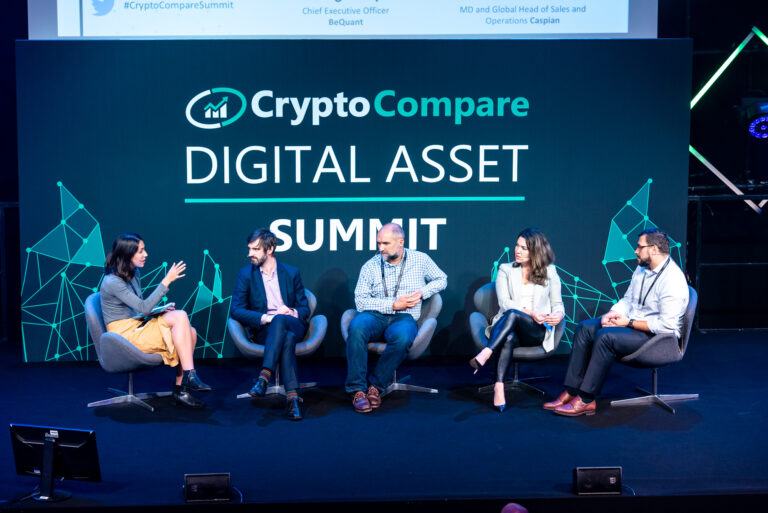On Wednesday, 12 June, a crowd of 700 assembled at London’s iconic Old Billingsgate market for the CryptoCompare Digital Asset Summit. Bringing together an assortment of institutional, retail and regulatory enthusiasts and experts, the event provided a full day of lively discussion on the topics that matter most in the crypto and blockchain space. Armed with a sharp pen and a bottomless supply of coffee, I sat through the day’s panel discussions.
Here are my key insights on six of the sessions…
Panel 1: The Future of Stablecoins
Moderator: Joon Ian Wong (CoinDesk)
Panellists: Dr Garrick Hileman (Blockchain), Jennifer Senhaji (MakerDAO), Marcos Viriato (Parfin), Simona Macellari (Ekon Gold)
Topics covered: Facebook’s GlobalCoin venture, ongoing issues with Tether, developments in the MakerDAO ecosystem, future need and use cases for stablecoins.
Key takeaways:
- The launch of ‘Facebook coin’ could be one of the most significant moments in crypto history with the potential to onboard a proportion of Facebook’s 2.4 billion monthly active users into digital currencies. Furthermore, the fact that Facebook employees will reportedly be able to take a portion of their wages in the currency provides a solid use case. What’s as yet unknown is whether the currency will be tradeable and the extent to which users will have privacy in the transactions they make. The key question to be answered is: will GlobalCoin be competing against Bitcoin or PayPal (i.e. is it a cryptocurrency or a payments system)?
- Whether or not Tether poses systemic risk to the crypto markets is hard to answer, but what’s been clear from recent events is that we need greater transparency. Tether has helped to put stablecoins on the map, but while the audit issue lingers it will likely be a concern for regulators, especially with the prospect of a Bitcoin ETF. From an institutional perspective, having a stable asset within the crypto ecosystem is valuable but transparency is essential for adoption.
- There is immense value in having a trust-minimised stablecoin that doesn’t require a counterparty, and Maker is leading in this respect (DAI’s user growth is currently around 20% per month). We’re yet to see an ‘optimal’ solution and can expect further evolution in this space. While Facebook coins will likely ‘compete’ with existing stablecoins, there are still barriers such as whether (for example) Apple would accept GlobalCoin as payment.
- As the space matures, we can expect to see a marketplace of stablecoins geared towards two primary use cases:
- Making the journey between the ‘traditional’ and the ‘new world’ of finance
- Supporting the underbanked (e.g. DeFi, disaster relief management)
Panel 2: Insights from the Regulators
Moderator: Lawrence Wintermeyer (Global Digital Finance)
Panellists: Martin Etheridge (Bank of England), Gillian Dorner (HM Treasury), Samantha Emery (FCA)
Topics covered: The institutional perspective of crypto, the work of the UK Government’s Cryptoassets Taskforce, the global regulatory environment
Key takeaways:
- There has been a noticeable shift in the institutional ‘narrative’ around crypto. Last year it was that central bankers don’t have anything against crypto, nor do they see it pose a systematic risk, but they simply can’t see a clear use case. The current narrative is becoming that Bitcoin is a hedge against central banking. This is being supported by instances of institutions moving into digital assets, such as JP Morgan’s ‘JPM Coin’.
- The UK’s Cryptoassets Taskforce involves The Treasury, the Bank of England and the FCA, and aims to support the UK’s position as a world-leading financial centre. It has been assessing the risks and benefits of crypto assets. It has identified four broad risk categories:
- risks to consumers (risk of loss),
- risk of illicit activity (money laundering),
- risk of market activity (systematic risk),
- risk to national stability (not an issue)
- The goal is to mitigate these risks (e.g. through the EU’s anti-money laundering directive) while supporting the benefits (of which there currently aren’t any identified, but these may emerge ‘further down the line’).
- The Government’s taskforce has conducted qualitative research into whether crypto poses a risk to consumers. The research found that consumer understanding of crypto assets is low, investors fail to do due diligence, but the extent of the harms is limited.
- The Bank of England does not view cryptoassets as performing the function of money due to significant volatility and lack of meaningful examples of mediums of exchange. While there is no material threat to the UK’s financial stability posed by crypto assets, the BOE cannot rule out that these may emerge in future.
Panel 3: Opportunities and Challenges – From Finance to Crypto
Moderator: Paul Gordon (Quantave)
Panellists: Gabor Gurbacs (VanEck), Sam Chadwick (UBS), Pina Emirdag (State Street), Ruth Wandhofer (Pendo)
Topics covered: encouraging financial institutions to participate in crypto, settlements using blockchain, a Bitcoin ETF
Key takeaways:
- Settlement between institutions is a promising use case for blockchain. It’s been tried before but the technology wasn’t sufficient to facilitate. UBS has been driving its Settlement Coin initiative; it isn’t attempting to be a cryptocurrency, but can help optimise liquidity and velocity between parties that transact regularly. Stock exchanges was cited as an area where real-time finality would be immensely valuable.
- Blockchain presents a new frontier for financial institutions such as banks to interface with. The issue isn’t innovation, but getting the balance right between innovation projects and maintaining standard business operations.
- For a crypto ETF to be approved, the missing pieces are accurate pricing of assets, custody solutions and surveillance of manipulation. Efforts to improve are being made in each of these areas, but may take time. Custody, for example, requires the involvement of service providers with a strong reputation in more traditional markets.
- A question remains around the conflict between Bitcoin’s ideal (e.g. self-sovereign, censorship resistant, etc.) and the needs and requirements of enterprise. These may never be fully aligned.
Panel 4: Getting Funded – A View from VCs Investing in the Space
Moderator: Teana Baker-Taylor (Global Digital Finance)
Panellists: Shane Kehoe (SVK Crypto), George McDonaugh (KR1), James Roy Poulter (The Reserve), Ami Ben David (Spice VC)
Topics covered: investment trends, advice for crypto entrepreneurs, blockchain growth hubs
Key takeaways:
- The space has no shortage of great ideas, but what’s required is execution. VC’s will therefore favour entrepreneurs with a track record of executing.
- In a space as nascent as crypto, the importance of network cannot be understated. The top talent is typically known within existing networks, so new talent has to focus on building a reputation among their peers.
- VCs typically won’t move fast on new projects. They will take the time to get comfortable with the team and establish a relationship. As there are relatively few VCs in the space with the depth of knowledge to really assess new projects, firms will typically look at who else is investing when making their own decisions.
- We can expect the next multi-billion-dollar IPOs to come from the crypto space. What’s harder to predict is where those unicorns will come from. Silicon Valley is losing its control over innovation, and New York and London are growing in stature due to the pools of tech and financial talent in the cities.
Panel 5: Market Integrity and Consumer Protection
Moderator: Jemima Kelly (FT Alphaville)
Panellists: Ted Lin (Binance), Will Harborne (Ethfinex), Austin Alexander (Kraken), Chen Arad (Solidus Labs)
Topics covered: market manipulation, transparency in exchange operations, ICOs/IEOs.
Key takeaways:
- A major issue exists in crypto around fake exchange volumes. It’s a self-perpetuating issue – less established (or scam) exchanges want to give the appearance of high volume so they can appear on CoinMarketCap (the best advertising space in the industry), this gives investors the belief that there’s liquidity in alts to entice them to use the platforms. There’s no incentive for the platforms to stop engaging in fraudulent practices such as wash trading, and only the data aggregation sites can change this situation.
- More honest exchanges are leading the conversation on this (possibly pushed by regulators) to expose dishonest actors. Market data is still not reliable enough to properly identify where the issues lie.
- Traders and investors are increasingly converging on platforms they can trust. This is a competitive advantage for platforms such as Binance, Kraken, etc. over platforms that facilitate wash trading. With the growth of IEOs, this is more evident – investors trust platforms like Binance to do due diligence and pick only the best projects for their launches. Binance also supports consumer knowledge by producing research materials on the projects it lists.
- We need to acknowledge that crypto markets are a different beast to traditional, highly regulated markets (e.g. equity markets). In crypto markets, tokens can be traded on multiple exchanges, which makes a difference for price discovery.
- The US is at a critical point where it risks pushing exchanges offshore to escape heavy-handed regulation. Exchanges that have chosen to remain in the US (e.g. Kraken) have suffered as a result. Parallels exist with the forex markets, where few US-based venues remain.
Panel 6: Institutionalizing Crypto – The Future State of the Digital Asset Market
Moderator: Isabel Woodford (The Block)
Panellists: Meltem Demirors (CoinShares), Max Boonen (B2C2), George Zayra (BeQuant), Chris Jenkins (Caspian)
Topics covered: Institutional interest in crypto, infrastructure, Bakkt, Bitcoin’s cypherpunk roots
Key takeaways:
- When we talk about the ‘big guys’ coming to join the space, there’s confusion on who we’re actually talking about. Many prop trading firms, hedge funds and brokers are already involved in crypto, but what’s missing is the large asset management companies such as Schroeder’s. The question is whether we really need them, or if the real opportunity is in drawing greater retail involvement.
- The big institutions haven’t come because of gaps in infrastructure, regulation, and organisational mandates to invest in a risky sector. We need an evolution of the marketplace before they can become involved. There’s also a significant intellection hurdle to overcome in order to ‘believe’ in the premise of Bitcoin. Other major barriers include market liquidity, on and off ramps that align with institutional models, the lack of fundamental analysis tools to identify investable opportunities and the reputational risks associated with people involved in an asset class that ‘hasn’t been PR friendly’.
- Whether or not Bakkt will be the ‘game changer’ many in the space are hoping for remains to be seen. Bakkt’s owner, ICE knows how to attract users to their platforms and their involvement brings credibility to the space. The fact that the Bitcoins futures product is physically settled is a ‘big deal’. The main risk is if Bakkt enters the space then finds that the institutional interest simply doesn’t exist, which would really damage crypto’s credibility.
- Does institutional involvement infringe on the ‘anti-establishment’ ideology of bitcoin? It will certainly benefit the community to have greater investment in crypto companies and infrastructure, however the ideologies of institutionalisation and self-sovereignty are fundamentally incompatible and will ultimately come to a head.









